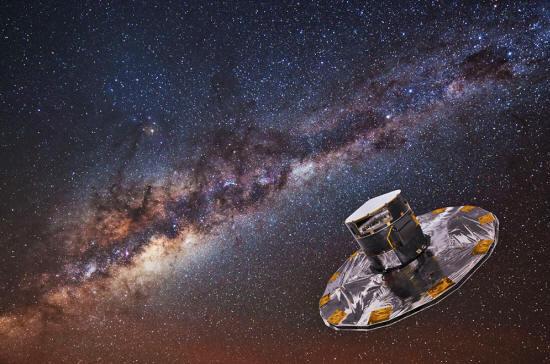|

by Dr. Jason Hunt
and Chris Sasaki
February
13, 2017
from
Dunlap Website
|
The
Dunlap Institute for Astronomy & Astrophysics at the
University of Toronto is an endowed research institute
with over 40 faculty, postdocs, students and staff,
dedicated to innovative technology, ground-breaking
research, world-class training, and public engagement.
The research themes of its faculty and Dunlap Fellows
span the Universe and include: optical, infrared and
radio instrumentation; Dark Energy; large-scale
structure; the Cosmic Microwave Background; the
interstellar medium; galaxy evolution; cosmic magnetism;
and time-domain science.
The Dunlap Institute, Department of Astronomy &
Astrophysics, Canadian Institute for Theoretical
Astrophysics, and Centre for Planetary Sciences comprise
the leading centre for astronomical research in Canada,
at the leading research university in the country, the
University of Toronto.
The Dunlap Institute is committed to making its science,
training and public outreach activities productive and
enjoyable for everyone, regardless of gender, sexual
orientation, disability, physical appearance, body size,
race, nationality or religion. |

A composite image
shows the Gaia spacecraft
against a backdrop of the Milky Way Galaxy.
Image: ESA/ATG medialab;
background image: ESO/S. Brunier
Toronto
Using a novel method and
data from the Gaia space telescope, astronomers from the University
of Toronto have estimated that the speed of the Sun as it orbits the
centre of the Milky Way Galaxy is approximately 240 kilometers per
second.
In turn, they have used that result to calculate that the Sun is
approximately 7.9 kiloparsecs from the Galaxy's centre - or almost
twenty-six thousand light-years.
Using data from the Gaia space telescope and the RAdial Velocity
Experiment (RAVE) survey, Jason Hunt and his colleagues
determined the velocities of over 200,000 stars relative to the Sun.
Hunt is a Dunlap Fellow
at the Dunlap Institute for Astronomy & Astrophysics, University of
Toronto.
The collaborators found an unsurprising distribution of relative
velocities: there were stars moving slower, faster and at the same
rate as the Sun.
But they also found a shortage of stars with a Galactic orbital
velocity of approximately 240 kilometers per second slower than the
Sun's.
The astronomers concluded
that the missing stars had been stars with zero angular momentum;
i.e. they had not been circling the Galaxy like the Sun and the
other stars in the Milky Way Galaxy:
"Stars with very
close to zero angular momentum would have plunged towards the
Galactic centre where they would be strongly affected by the
extreme gravitational forces present there," says Hunt.
"This would scatter
them into chaotic orbits taking them far above the Galactic
plane and away from the Solar neighbourhood."
"By measuring the velocity with which nearby stars rotate around
our Galaxy with respect to the Sun," says Hunt, "we can observe
a lack of stars with a specific negative relative velocity.
And because we know
this dip corresponds to 0 km/sec, it tells us, in turn, how fast
we are moving."
Hunt and his colleagues
then combined this finding with the proper motion of the
super-massive
black hole known as
Sagittarius A*
("A-star") that lies at the centre of the Galaxy to calculate the
7.9 kiloparsec distance.
Proper motion is the motion of an object across the sky relative to
distant background objects.
They calculated the
distance in the same way a cartographer triangulates the distance to
a terrestrial landmark by observing it from two different positions
a known distance apart.
The result (Detection
of a Dearth of Stars with Zero Angular Momentum in the Solar
Neighborhood) was published in Astrophysical Journal
Letters in December 2017.
The method was first used by Hunt's co-author, current chair of the
Department of Astronomy & Astrophysics at the University of Toronto,
Prof. Ray Calberg, and Carlberg's collaborator, Prof.
Kimmo Innanen.
But the result Carlberg
and Innanen arrived at was based on less than 400 stars.
Gaia is creating a dynamic, three-dimensional map of the Milky Way
Galaxy by measuring the distances, positions and proper motion of
stars.
Hunt and his colleagues
based their work on the initial data release from Gaia which
included hundreds of thousands of stars. By the end of its 5 year
mission, the space mission will have mapped well over 1 billion
stars.
The velocity and distance results are not significantly more
accurate than other measurements.
But according to Hunt,
"Gaia's final release
in late 2017 should enable us to increase the precision of our
measurement of the Sun's velocity to within approximately one
km/sec, which in turn will significantly increase the accuracy
of our measurement of our distance from the Galactic centre."
Additional
notes
1) The RAdial
Velocity Experiment, or RAVE, is a survey of stars conducted at
the Australian Astronomical Observatory (AAO) between 2003 and
2013.
It measured the
positions, distances, radial velocities and spectra of
half-a-million stars - over two hundred thousand of which are
included in Gaia data.
|


